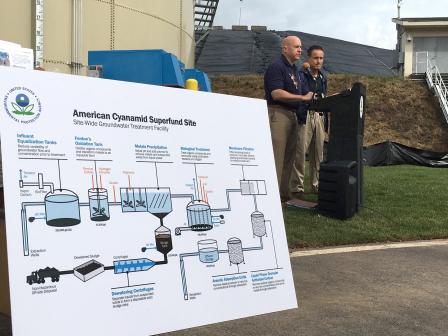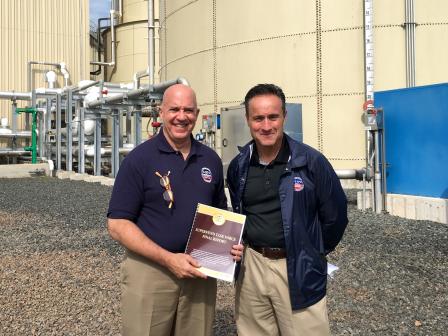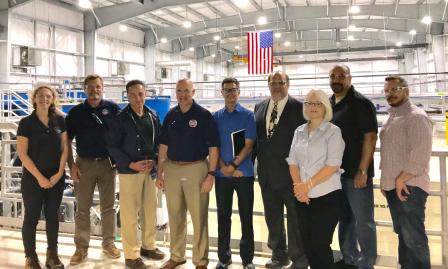News Releases from Region 02
EPA Makes EPA Superfund Task Force Announcement at Newly Constructed Groundwater Treatment Plant at the American Cyanamid Site in Bridgewater, NJ
Bridgewater, New Jersey – Today, U.S. Environmental Protection Agency (EPA) Assistant Administrator for the Office of Land and Emergency Management Peter Wright and Regional Administrator Pete Lopez announced the completion of the Superfund Task Force and issued the Task Force’s final report outlining significant accomplishments over the past two years at Superfund sites across the country. Assistant Administrator Wright and Regional Administrator Lopez made the announcement at the American Cyanamid Superfund Site in Bridgewater, New Jersey, where they visited a newly completed, state-of-the-art groundwater treatment facility at the site.
 EPA Assistant Administrator Peter Wright and Regional Administrator Pete Lopez announced the completion of the Superfund Task Force at the American Cyanamid Superfund Site in Bridgewater, NJ
EPA Assistant Administrator Peter Wright and Regional Administrator Pete Lopez announced the completion of the Superfund Task Force at the American Cyanamid Superfund Site in Bridgewater, NJ
“Today we celebrate the significant progress the Task Force has made throughout the Superfund Program over the last two years. It is truly impressive and already paying dividends for communities across the country,” said EPA Assistant Administrator Peter Wright. “I am excited that the work will not stop here but will continue as we move forward. We are committed to working closely with our partners and the people living near our sites as we integrate the improvements and lessons learned at all sites on the National Priorities List.”
“The Superfund Task Force helps contaminated properties like American Cyanamid reach their cleanup goals efficiently and effectively,” said EPA Regional Administrator Lopez. “Nationwide, sites emphasized through the Superfund Task Force have accelerated their remediation measures, revitalized communities and more effectively engaged partners and stakeholders.”
 EPA Assistant Administrator Peter Wright and Regional Administrator Pete Lopez with the Superfund Task Force’s final report outlining significant accomplishments over the past two years
EPA Assistant Administrator Peter Wright and Regional Administrator Pete Lopez with the Superfund Task Force’s final report outlining significant accomplishments over the past two years
American Cyanamid was one of the first Superfund sites listed on the Administrator’s Emphasis List in December 2017. It was removed from the Administrator’s Emphasis List once it met its significant milestone - the proposal of a cleanup plan, which was finalized September 2018.
In addition, a state-of-the-art groundwater treatment facility began operations at the site this summer. It was built as part of a previous cleanup plan established in 2012 designed to address contaminated groundwater and keep harmful contaminants like benzene from reaching the Raritan River or migrating to other off-site areas.
The American Cyanamid Superfund Site has a history of industrial pollution dating back to 1915. For nearly 100 years, the location was used for the manufacturing of chemicals. Several impoundments were constructed and used for waste storage and disposal, which resulted in the wide-spread contamination of soil and groundwater.
 EPA Assistant Administrator Peter Wright and Regional Administrator Pete Lopez with the Region 2 American Cyanamid Superfund team at the facility in Bridgewater, NJ
EPA Assistant Administrator Peter Wright and Regional Administrator Pete Lopez with the Region 2 American Cyanamid Superfund team at the facility in Bridgewater, NJ
Commissioned in May 2017 to provide recommendations on how EPA could streamline and improve the Superfund Program, the EPA’s Superfund Task Force issued its initial report in July 2017 with 42 recommendations in five goal areas. Based on the collective experience of EPA’s career staff and others, the recommendations offered important suggestions for improving the program and expediting site cleanups through remediation and back to productive use. By implementing the recommendations over the past two years, the Task Force has helped to provide certainty to communities, states, tribes and developers that the nation’s most hazardous sites will be cleaned up as quickly and safely as possible.
The important work of the Task Force will continue under the Superfund Program and at all sites on the National Priorities List (NPL). The agency will continue to prioritize expediting cleanups to protect people’s health and the environment. Moving forward, the agency plans to:
- Improve accountability and ensure the work continues in the future by tracking and reporting on our progress with a new set of performance measures: https://19january2021snapshot.epa.gov/superfund/superfund-task-force-metrics.
- Conduct a strategic and comprehensive portfolio review of every site remaining on the NPL to enable EPA to better utilize the Task Force’s tools and lessons learned in advancing cleanups across the country.
- Continue to identify and implement new opportunities and approaches to improve the program’s performance and effectiveness.
Highlights of the Superfund Task Force Accomplishments
Goal 1: Expediting Cleanup and Remediation - The Task Force developed several tools to expedite cleanup and remediation at sites including the Administrator’s Emphasis List, a list of sites targeted for the administrator’s immediate and intense attention. The agency will continue using the Emphasis List to focus on sites needing immediate and intense attention and will update the list quarterly. Substantial progress has been made at sites on this list, for example:
- New Castle, Delaware: At the Delaware Sand and Gravel Landfill Superfund Site a settlement with responsible parties was secured allowing the initiation of pre-design work and installation of two groundwater interceptor wells to protect water supply wells.
- Picher and Cardin, Oklahoma: At the Tar Creek Superfund Site the Agency brought together various parties to develop a long-term strategy to manage risks, cleanup, and economic opportunities at the site.
Goal 2: Re-Invigorating Responsible Party Cleanup and Reuse - The Task Force developed new enforcement guidance for EPA’s regional offices to accelerate remedial design starts at potentially responsible party (PRP)-lead Superfund sites. Moving forward, the guidance’s recommended settlement strategy will be considered by EPA regions as a matter of national practice. This guidance has accelerated work at several sites, for example:
- Calvert City, Kentucky: At the B.F. Goodrich Site EPA negotiated a settlement agreement with PRPs for the remedial design. The agreement allows the PRPs to begin designing the cleanup while negotiating a separate agreement for the remedial action phase of the cleanup.
Goal 3: Encouraging Private Investment - The Task Force recognized that EPA should support, where appropriate, innovative approaches to promote third-party investment in cleanup and reuse of contaminated properties consistent with statutory authorities. By the end of 2019, EPA plans to issue a memorandum to EPA regional offices to promote this approach where appropriate and in the interest of the Superfund Program, for example:
- Fredericktown, Missouri: At the Madison County Mines Site, EPA entered into an administrative settlement with Missouri Mining Investments, LLC to conduct removal actions at the site. This will result in the consolidation and capping of on-site mine waste and allow the approximately 1,750-acre property to be redeveloped for future mining of cobalt and other metals.
Goal 4: Promoting Redevelopment and Community Revitalization - The Task Force worked to increase the number of NPL sites that are returned to communities for redevelopment through focused management attention and improved program practices. In Fiscal Year (FY) 2018, EPA achieved the goal sitewide ready for anticipated use at 51 sites, the highest total since FY 2013. EPA will continue to post specific information about sites available for redevelopment prominently on the Superfund Redevelopment website for stakeholders, developers, and businesses seeking information, for example:
- Libby, Montana: The agency identified the Libby Asbestos Superfund Site and the Libby Groundwater Contamination Superfund site as redevelopment opportunities. In addition to a cleanup that restored neighborhoods and business areas, parts of the sites are now in reuse. The Riverfront Park now has river access, pavilions, a memorial, parking, and picnic tables.
Goal 5: Engaging Partners and Stakeholders - The Task Force initiated a number of ongoing outreach activities to engage communities near Superfund sites, for example:
- Partnership and Stakeholder Engagement Strategy: EPA developed and released a “Partnership and Stakeholder Engagement Strategy”(https://semspub.epa.gov/work/HQ/100000860.pdf) to strengthen EPA partnerships and increase public participation and transparency at Superfund sites across the country.
- Risk Communication Strategy: The agency developed a plan (https://semspub.epa.gov/work/HQ/199586.pdf) to improve risk communication and community involvement practices during the long-term stewardship phase of Superfund site remediation. Lessons learned from implementing this plan will be applied across the life-cycle of the Superfund process.
More information on EPA’s Superfund Task Force and the final Superfund Task Force Report can be found at: https://19january2021snapshot.epa.gov/superfund/superfund-task-force-recommendations-and-accomplishments
A storyboard highlighting Superfund Task Force success stories from across the country can be found at: https://epa.maps.arcgis.com/apps/MapSeries/index.html?appid=21708909e0164750b20b351e2d931092
19-077 # # #

